START HERE CLL Resource Guide 2 en Español
Spanish START HERE CLL Resource Guide_Brander
Share Your Feedback
Create your own user feedback survey
Spanish START HERE CLL Resource Guide_Brander
Create your own user feedback survey
START HERE CLL Resource Guide_Brander
Download Resource Guide | Descargar Guía en Español
Create your own user feedback survey
Download Resource Guide | Descargar Guía en Español
Create your own user feedback survey
How to Make Confident and Informed CLL Treatment Decisions from Patient Empowerment Network on Vimeo.
How can you engage effectively in your CLL care? Collaborating with your doctor and playing an active role in your care can lead to improved outcomes. This animated video reviews essential steps and important considerations for making informed and confident CLL treatment decisions.
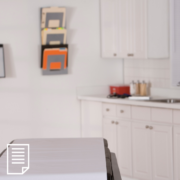
|

|

|
Elena:
Hi, I’m Elena and this is my husband, Bill.
Elena:
Several years ago, I was diagnosed with CLL, which stands for chronic lymphocytic leukemia. CLL is a blood cancer that starts in the bone marrow. It’s the most common type of adult leukemia.
When I was first diagnosed, I wasn’t treated right away. It was confusing at the time, but my CLL doctor, Dr. Singh, told me that most people with CLL don’t need to be treated immediately.
Here’s Dr. Singh, he can explain it further.
Dr. Singh:
Hi! I’m Dr. Singh, and I’m a hematologist specializing in the care and treatment of people with CLL.
At first, we approached Elena’s CLL with “watch and wait” or active surveillance. Through physical exams, blood work and frequent communication, we monitored how her CLL was progressing over time.
Elena:
I was in watch and wait for about a year—then, I begin to have symptoms that interfered with my daily life. I had drenching night sweats and I felt so exhausted.
Dr. Singh:
Right! An increase in symptoms is often an indicator that it’s time to treat a patient’s CLL. Elena’s fatigue and night sweats are common symptoms. Other symptoms can include enlarged lymph nodes or spleen, fever, unintentional weight loss and frequent infections.
In addition to an increase in symptoms, signs that it might be time to treat can include anemia or low platelet counts.
Elena:
So, once Dr. Singh let me know it was time to treat my CLL, he walked me and Bill through the goals of treatment.
And by that, I mean we discussed balancing my lifestyle with finding an effective treatment for my CLL.
Dr. Singh:
Elena let me know that she’s very social and enjoys riding her bike – we wanted to make sure she could continue doing the activities she loves.
The clinical goals of CLL treatment are to slow, stop or eradicate the cancer. I spoke with Elena and Bill about finding an approach that may get her CLL under control while preserving her quality of life.
Elena also had essential testing, including biomarker testing, which we took into consideration along with her treatment goals. We reviewed each potential approach to make sure we found the best, most personalized treatment option for HER CLL.
We discussed the effectiveness of the treatment option, and the likelihood of a recurrence a. And we reviewed what our next steps would be if the treatment plan needed to be adjusted.
Bill:
And I wanted to make sure Elena was able to continue feeling her best, so I asked about potential side effects for each therapy and how it could impact our lifestyle.
Dr. Singh:
Exactly! We discussed how each treatment option could affect Bill and Elena’s daily life. You and your doctor may also consider:
Elena:
In addition to asking questions, Bill took notes during our appointments, since it was often hard for me to absorb everything at once.
Bill:
We also made sure to talk about the appointment on our way home, while the information was fresh on our minds. And we did our part by researching CLL and bringing a list of questions to each appointment.
I found an office visit planner on the Patient Empowerment Network website that helped me organize my health info and questions.
Dr. Singh:
As you can see, Bill and Elena were actively engaged in each care decision. It’s vital that patients feel empowered to speak up. If you can, bring a friend or loved one along to your appointment.
And, if you are able, it’s a good idea to seek a second opinion or a consultation with a CLL specialist to help you feel confident in your care decisions.
Elena:
Dr. Singh made Bill and I feel included in the decision-making process, as if it were a collaboration.
Dr. Singh:
That’s right. This is a partnership. So, what steps can you take to be more engaged in your CLL care?
Bill:
That’s great advice, Dr. Singh. To learn more, visit powerfulpatients.org/CLL to access a library of tools.
Elena:
Thanks for joining us.
How Can CLL Patients Insist on Better Care? from Patient Empowerment Network on Vimeo.
How can chronic lymphocytic leukemia (CLL) patients insist on better care? Dr. Lindsey Roeker shares key advice for discussing testing and provides important questions to ask your doctor for the best care for you.
Dr. Lyndsey Roeker is a hematologic oncologist at Memorial Sloan Kettering Cancer Center. Learn more about Dr. Roeker here.
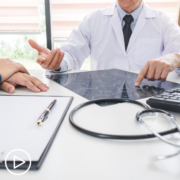
|
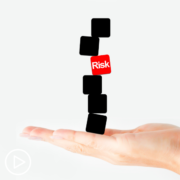
|
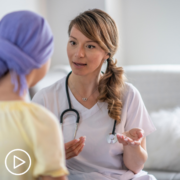
|
Katherine:
Patients should insist on essential CLL testing. It’s important to point out that some patients may not know if they’ve received these important tests, so how can they take action?
Dr. Roeker:
So, the next time you’re at your doctor, ask, “I just want to know more about the prognosis of my CLL, and can we talk through the genetic markers of my disease, to help me understand what to expect?” That’s kind of code for, “Let’s go through all of these test results,” and it also – if you have a provider who doesn’t routinely test them at diagnosis, and for instance, just tests before treatment, they can also kind of give you their sense of when they do the testing, so you know what to expect. And I think that’s an important discussion to have with your provider, for sure.
Katherine:
Are there key questions that patients should ask their physicians?
Dr. Roeker:
I’m always impressed with the questions that people come up with. I think one of the best is, what should I expect, based on what we’re doing now? It’s always a hard question to answer because, obviously, for any patient, it’s so individualized, but I think understanding what to expect, as a general sense, is a good way to approach both treatment and prognosis, and all of those kinds of things.
How Can CLL Patients Mitigate Distance and Technology Barriers to Care? from Patient Empowerment Network on Vimeo.
How can chronic lymphocytic leukemia (CLL) patients overcome barriers to their CLL care like distance, technology, and other challenges? Dr. Kathy Kim from UC Davis School of Medicine details the challenges she’s witnessed for patients and some ways that both patients and providers can help bridge the gaps to optimal patient care.
See More from Best CLL Care No Matter Where You Live
Dr. Awan:
So is it going to be financially difficult to let’s say, get an app or download an app, which might have a subscription service, attached to it, so that’s the first question that I might have. And the second question is then, this is something that I run into every day. A lot of my patients are older. Some of my patients live on farms, a couple of hours, three, four hours away from Dallas in a relatively rural area, east or west of us in north Texas, and you know those people may not necessarily have access to broadband, they may not have access to high-speed internet. So, they may not be able to get online, or if they do get online, the connections are not the most perfect, so it’s always, the video is not pretty good, or they frankly, may not know how to operate, they don’t just don’t feel comfortable operating these devices or the tablets or phones, even though they might use them for making calls and texting, but they may not necessarily be very conversing with them or very at ease with them, so are those options really difficult for our patients to use?
Dr. Kim:
Yeah, so you’ve mentioned three really key areas, cost, connectivity, and what I will call digital literacy or digital familiarity, those are really three key areas that we need to address for anyone who wants to use these tools to be able to use them. So, cost is the first thing, most mobile apps are fairly inexpensive, and if you’ve downloaded anything from the Apple Store or the Google Play store, almost everything is free, or a few things might have you know $2.99, $8.99. Some of them do have subscription fees. So, the app itself is probably the least expensive part of it. The more expensive part is, do you have a modern smartphone that can actually, where you can download that up or do you have a modern tablet or a newer laptop that can actually use apps, right? Not just software, but apps, those devices is where the cost really comes in, and you know if you’ve got any kind of device, it’s every couple of years, you have to replace it or upgrade it to kind of keep it up-to-date. So that is definitely a barrier of the cost of the computing device or remote patient monitoring device, and that is where we really need to collaborate in the industry with our hospital systems and our provider systems, with our legislative representatives, with our insurance companies, to provide low-cost access to the devices.
The third thing is connectivity, which is both cost, and it is a cost as well as an accessibility issue, and for most of the uses in healthcare, as you’ve mentioned, we need to be able to do video, we need to be able to connect to the devices for data, and that means we either have to have a cell phone data , a mobile data plan that can run data on your phone or your tablet, or you need a broadband connection in your home, an actual Wi-Fi plan that comes installed. You need one or the other. And again, either of those options are quite expensive, if you do video visits, it can really eat up your bandwidth if you’re on a low band, low bandwidth plan or you’re paying for the minute or by the bit. It can become very expensive, so we have to have a cost-effective plan available to people, and again, there’s lots of policies or proposals, to be submitted both at the state level, and there are federal programs that are actually now subsidizing. So specifically, under COVID, provider organizations can apply to the federal government for special funds to offer telehealth help to patients, so many providers have bought tablets or other remote patient monitoring devices or things like that, that they can give out to patients.
Which brings us to the third thing that you mentioned, which is digital familiarity or digital literacy. We have to help people learn how to use these. So even if you use a cell phone, it’s different using a smartphone, right? The apps are different, the navigation is different, how you touch your screen is different, how these applications actually work, and how to get the data from your own device to a provider, to your doctor is a whole another set of skills, right? Do you have to pair these devices, do you have to register an account and have a password? Do you have to approve your doctor to get access, there’s all these questions about how you would actually do all this and this is where organizations like Patient Empowerment Network, that I know does a lot of effort to help patients more how to use technology, as well as the research that we have been doing at UC Davis in the community about how to support patients overcome all these barriers becomes really critical, we have to actually work together to make sure all three of these issues are addressed so that everybody can have access.
What Multi-Language Technology Innovations Are Available for Cancer Patients and Families? from Patient Empowerment Network on Vimeo.
What are available innovations for chronic lymphocytic leukemia (CLL) patients who speak languages besides English? Dr. Kathy Kim and Dr. Farrukh Awan share their perspectives on interpreter services and multi-language technology innovations for patients who need Spanish, Vietnamese, Korean, Chinese, and other languages for improving their CLL knowledge and care.
See More from Best CLL Care No Matter Where You Live
Dr. Awan:
Another issue that we have seen is that some of our patients and we live in a town that has a substantial percentage of Hispanic-speaking or Spanish-speaking people, so we actually have access to a lot of resources and a lot of options for those patients, but there might be some limitations in people who don’t necessarily speak English as the first language, so what kind of tools do we have for those people, what kind of resources can they access to? So, Dr. Kim, anything for those patients?
Dr. Kim:
Yes, and we have really made an effort in our own research to any of the resources that we provide, the mobile applications that we use are available in multiple languages, and I will say Spanish is the most common one that we are able to support. Of course, there are many, many languages spoken in the United States, beyond English and Spanish that we do, we are challenged when we try to find other resources or applications that can be in Chinese and Korean and in other languages. It’s really challenging. So, in our own work, we have developed applications, and this is in research, so these are not things that are necessarily available in practice. We have developed applications for example, for care coordination for patients undergoing chemotherapy or to support shared decision-making at the beginning of your cancer journey between a patient and their family and a clinician, and when we develop those applications, as I said, we, obviously, I don’t speak Spanish, I only speak English, so I’m limited as to what I can develop. I can develop it in English, but then we always try to co-design it with clinicians who speak that language and with patients, so we do a lot of co-design with patients so that when we create it we’re making sure that it seems appropriate when it’s produced in other languages, and then we always test it with people who are native speakers in that language as well, so that’s one.
So many of the educational resources, our website information, our mobile applications, there is no reason why we can’t have those available in multiple languages. I think it is more challenging when you’re trying to build a relationship with a provider, with your doctor or with your nurse, or nurse practitioner and the patient don’t speak the same language, and then we have to rely on interpreter services. And I will say that that has not quite made the leap that we’d hoped with telehealth, to integrate an interpreter into your telehealth visit is quite challenging, and I’ve heard of doctors and patients being on a televisit and then the doctor calls the interpreter on their cell phone and tries to put that speaker up to the speaker on the computer, and that it’s not the best experience for anybody. So, that is an area that we would really like to work on, how do you have interpreter services really integrated into telehealth so it’s smooth for everybody.
Dr. Awan:
And let me share my experience, just this week, actually, on Monday, I was in clinic and we frequently have patients who speak Spanish, and we have in-person Spanish interpreters that are readily available, so one of my patients was a Spanish speaker, so I had the interpreter in the room with me, so that interaction went really well, the patient’s daughter was also obviously able to interpret some of that, so it was a fairly easy conversation, we explained, we talked about treatment options and what the plan is, so that went really well, My next patient was a Vietnamese speaking patient, so we don’t have those in person, so my nurse got me this iPad, which was on a mount, it’s like a dolly that can go from room to room, and I
turned it on and I was expecting some issues and they basically had a screen for me saying what language do you want, and I said Vietnamese, and then literally 30 seconds I was connected to a Vietnamese speaking interpreter, and they were able to see me, see the patient and the patient was able to see them. So, it was almost like having an interpreter in the room.
I think it always helps to have an interpreter in the room, in the event that you have to explain certain medical terminology, so my experience with this one application that our hospital subscribes to was very, very good.
I also found out that actually there are certain apps that if I want to print out a certain form or a certain patient education material and give it to the patient, okay, fine, this is the treatment you’re getting, these are the side effects, this is what to expect, there are options for translating it because they are already translated. You just hit the language you want, and that prints out the material in that language and you can give it to the patient to read, and I feel that that was a good resource to have. Similarly, being involved in multiple clinical trials, I feel that that is sometimes challenging option for a lot of patients, but I just wanna reassure everyone that all you have to do is ask. You can ask for a form in a specific language and it’s my responsibility, it’s my job to make sure that that translation is available to you so you can read it in your own language, and that is a service that is provided routinely by our cancer center, and I’m sure by a lot of other major academic centers and cancer centers in the country.
How Can CLL Patients Avoid Pandemic Challenges Without Compromising Quality of Care? from Patient Empowerment Network on Vimeo.
How can chronic lymphocytic leukemia (CLL) patients ensure that they receive quality care even during high-risk times like pandemics? Dr. Kathy Kim from UC Davis School of Medicine shares her recommendations for providers and information about remote monitoring devices for improved patient care.
See More from Best CLL Care No Matter Where You Live
Dr. Awan:
You know, with so many patients nowadays who are worried about their cancer care and how that will continue, and especially now with remote monitoring. How, what kind of tools do you have deployed and used, what would be your recommendations for us and how we can make us some of these new innovations and new methods to provide the best care for our patients?
Dr. Kim:
I think even when you’re thinking about using technology, again, it’s not one-size-fits all, it is what the provider is comfortable with and what the patient is comfortable with, and what you two can work together to improve your care. So, I think there are a lot of innovations that have been developed over many years, but this past year under COVID, we saw an acceleration of people adopting them because it was out of necessity that people didn’t come in to a setting where they might potentially be infected or to infect others. So, we certainly saw a huge increase in telehealth, which has been virtual visits, like we’re doing right now, we are virtually visiting with each other or telephone visits, so there’s been a huge upsurge in the number of hospitals and clinics and practices that have been able to implement telehealth with their patients. But there are other tools that again, have been in development that are now starting to take off under the last year, and those are remote patient monitoring devices, these are either specific medical devices, like blood pressure machines, glucose meters, some heart monitors, sleep monitors, you know things that, devices that check your oxygen saturation. So, there are many medical devices that are for use in the home, that are either covered by insurance or people can buy them at the drug store, and what has really come about this year is the ability to connect the data from the device you have in your home to your provider, so that’s been in place, but we really haven’t implemented it very many places, and now lots of places are allowing that connection to happen. So, the patient can use the device in their home and get it connected to the and have it sent to the hospital or to their doctor, so their doctor can be watching the data and also monitoring them, so that’s one really wonderful piece of progress that we’ve had in the past year. I would say the third area that again, has been around for a while but people haven’t used it so much has been mobile applications.
So, these are basically software that you can run on your smartphone or you can run it on a tablet or a computer that let you track your own information. So, I know CLL patients and many cancer patients have lots of documents from all the treatments, from all the visits that they have had, and it’s a challenge to manage all those medical records because you might go to multiple places, right? You’re not always going to the same place. So, now there are many applications that are integrated with the record systems that your hospital or doctor has, where you can aggregate all of your records in one place, and that way when you go to talk to another provider or have this second opinion or a consult, you have access to all your records that you can share. And then you can also track things that are important to you, so maybe you want to track how I feel, what my symptoms are under certain kinds of medications or when I do more physical activity, do I get more tired or do I actually feel better, you know track and by taking my other medications, and for many of us, just remembering to take your medications every day is hard enough if you have several medications and they’re at different times, you might not remember, did I take that one already or do I still need to take it? And so, these applications can also set up your medication schedule and help you to track whether you’ve taken them or not, so there are lots of these tools now available where you can start to manage all of these things and share that information with your doctor.
You know, with so many patients nowadays who are worried about their cancer care and how that will continue, and especially now with remote monitoring. How, what kind of tools do you have deployed and used, what would be your recommendations for us and how we can make us some of these new innovations and new methods to provide the best care for our patients?
I think even when you’re thinking about using technology, again, it’s not one-size-fits all, it is what the provider is comfortable with and what the patient is comfortable with, and what you two can work together to improve your care. So, I think there are a lot of innovations that have been developed over many years, but this past year under COVID, we saw an acceleration of people adopting them because it was out of necessity that people didn’t come in to a setting where they might potentially be infected or to infect others. So, we certainly saw a huge increase in telehealth, which has been virtual visits, like we’re doing right now, we are virtually visiting with each other or telephone visits, so there’s been a huge upsurge in the number of hospitals and clinics and practices that have been able to implement telehealth with their patients. But there are other tools that again, have been in development that are now starting to take off under the last year, and those are remote patient monitoring devices, these are either specific medical devices, like blood pressure machines, glucose meters, some heart monitors, sleep monitors, you know things that, devices that check your oxygen saturation. So, there are many medical devices that are for use in the home, that are either covered by insurance or people can buy them at the drug store, and what has really come about this year is the ability to connect the data from the device you have in your home to your provider, so that’s been in place, but we really haven’t implemented it very many places, and now lots of places are allowing that connection to happen. So, the patient can use the device in their home and get it connected to the and have it sent to the hospital or to their doctor, so their doctor can be watching the data and also monitoring them, so that’s one really wonderful piece of progress that we’ve had in the past year. I would say the third area that again, has been around for a while but people haven’t used it so much has been mobile applications.
So, these are basically software that you can run on your smartphone or you can run it on a tablet or a computer that let you track your own information. So, I know CLL patients and many cancer patients have lots of documents from all the treatments, from all the visits that they have had, and it’s a challenge to manage all those medical records because you might go to multiple places, right? You’re not always going to the same place. So, now there are many applications that are integrated with the record systems that your hospital or doctor has, where you can aggregate all of your records in one place, and that way when you go to talk to another provider or have this second opinion or a consult, you have access to all your records that you can share. And then you can also track things that are important to you, so maybe you want to track how I feel, what my symptoms are under certain kinds of medications or when I do more physical activity, do I get more tired or do I actually feel better, you know track and by taking my other medications, and for many of us, just remembering to take your medications every day is hard enough if you have several medications and they’re at different times, you might not remember, did I take that one already or do I still need to take it? And so, these applications can also set up your medication schedule and help you to track whether you’ve taken them or not, so there are lots of these tools now available where you can start to manage all of these things and share that information with your doctor.
How Can CLL Patients Be Active in Their Care Decisions? from Patient Empowerment Network on Vimeo.
How can chronic lymphocytic leukemia (CLL) patients take a more active role in their care decisions? Dr. Matthew Davids details considerations for CLL treatment and explains ways that patients can take action to ensure their patient voice is heard for their care.
Dr. Matthew Davids is Director of Clinical Research in the Division of Lymphoma at Dana-Farber Cancer Institute. Learn more about Dr. Davids here.
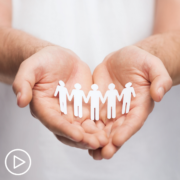
|

|
Katherine:
Lately we’ve been hearing the term “shared decision-making,” which basically means that patients and clinicians collaborate to make healthcare decisions.
And it can help patients take a more active role in their care. What are your thoughts, Dr. Davids, on how best to make this process work?
Dr. Davids:
Yeah, I fully support that model. I think for most patients it’s very helpful to be an important decision-maker. Really the patient is the ultimate decision-maker to say what they want for their own treatment. And sometimes it’s hard for me to predict what a patient will want for themselves, so I see my role for most patients as providing the information that they need to make the best decision possible for themselves.
I do try to steer patients a bit in the directions that I think they should be thinking. I’m not going to necessarily present a laundry list of things to patients. I’m going to try to narrow it down to what I think are the most reasonable choices for a patient to make.
I feel that’s part of my job. I do still have patients who just say, “Just tell me what to do,” and I respect that, too. Not all patients want to be part of shared decision making, and they just want me to decide, and that’s fine. But I do find that most patients like the idea of having a voice and being the one to decide, and that way I can help to guide them, but ultimately, it’s up to them.
Katherine:
Well, speaking of patients having a voice, are there questions that patients should consider asking when they’re thinking about a proposed treatment plan?
Dr. Davids:
Yeah. I think some of the key ones revolve around basic stuff, but sometimes it’s hard to think of it in the moment. But thinking about, what are the risks of this therapy? What are the specific side effects that are most common? When you look at a package insert or you look at a clinical trial consent form, you’re going to see 100 different side effects listed. I always promise patients, “You won’t have every single side effect that’s listed here, but you may have a couple of them.” And again, my role often is to identify which are the more common side effects that we see and how can those be managed?
And then, I think often you’re just asking simply about what are the potential benefits of this therapy? What are the odds that I’m going to get into remission? How long is this remission likely to last?
And then, something that is often challenging for patients to think about – it can be challenging for me as well – is to think about what’s the next step? So, I think a good question to ask is, “If I choose Therapy A, what happens if I need therapy again in a few years? What are the options at that point?” because we’ve been talking so far mostly about what we call frontline therapy, making that initial choice of treatment. But then, once you get into what we call the relapse setting, a lot of the decision of what to receive at that point depends on what you got as the first therapy. And so, trying to think at least one step ahead as to what the next options are I think can be helpful, certainly for the physicians but also for the patients.
Katherine:
Do you have any advice to help patients speak up when they’re feeling like their voice isn’t being heard?
Dr. Davids:
That’s always a challenging situation, but I encourage patients not to be shy about asking questions.
There’s often an imbalance in terms of the information where the oncologist may know more than the patient about a particular condition. And so, I think reading up and trying to educate yourself as much as you can. Whenever possible, including a family member or friend as part of the visit to also help advocate for you. And then, if you’re not being heard the way that you think you should be, thinking about seeking out another provider who may be able to listen more.
And sometimes that can be again helpful to have a touchpoint with a CLL specialist who may be able to reinforce some of what you’re thinking. If what you’re reading online or seeing online is different from what your oncologist is telling you, that may be a sign that it’s good to get a second opinion and just make sure you’re on the right track.
What Are the Goals of CLL Treatment? from Patient Empowerment Network on Vimeo.
What are some of the goals of chronic lymphocytic leukemia (CLL) treatment? Dr. Matthew Davids outlines some different treatment goals and how the goals are impacted by a patient’s age and other considerations.
Dr. Matthew Davids is Director of Clinical Research in the Division of Lymphoma at Dana-Farber Cancer Institute. Learn more about Dr. Davids here.

|
Katherine:
With CLL, what are the goals of treatment?
Dr. Davids:
I like to say to patients, “The goals are to make you live longer and live better.” You want to obviously have treatments that prolong life, but you also want to have treatments that are helping with symptoms, and giving patients more energy, and making them feel better, and protecting them from some of the risks of the disease. And so, I think the goals do vary a bit based on the stage of life that patients are at.
I see a lot of patients in their 70s and 80s, and in those patient’s symptom control, having the disease be in a good remission, allowing them to live their life is a good goal. I sometimes see patients in their 40s and 50s, and some of those patients want to be a bit more aggressive and try to do a strategy that will get them a very long-term remission, and even potentially explore potentially curative strategies.
If I have a higher-risk patient with deletion 17p who’s young and fit, and they’ve already had some of the novel treatments, that’s where we start thinking about clinical trials of some of the cellular therapies like CAR-T cells that people may have heard of where you use the T cells from the patient to try to use that as a therapy to kill off the disease. Or even a bone marrow transplant is something that we have used historically in CLL. We don’t use it as often now, but for younger patients with high-risk disease it’s still a consideration to try to achieve a cure of the CLL even though the risks of that are significant.
What Should CLL Patients Know About Clinical Trial Treatment Options? from Patient Empowerment Network on Vimeo.
What do chronic lymphocytic leukemia (CLL) patients need to know about clinical trial treatment options? Dr. Matthew Davids explains how clinical trials fit into the array of CLL treatments, the benefits of speaking to a CLL specialist, and online resources for finding clinical trials.
Dr. Matthew Davids is Director of Clinical Research in the Division of Lymphoma at Dana-Farber Cancer Institute. Learn more about Dr. Davids here.
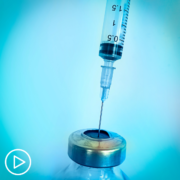
|
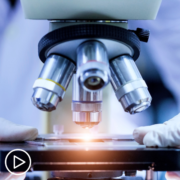
|
Katherine:
Right. Where do clinical trials fit in with the treatment approaches?
Dr. Davids:
So, clinical trials are really how we’ve made all these advances in CLL over the last decade. It’s how we learn about new treatments. It’s how we learn about how to optimize the treatments that we have. I think sometimes patients have a misconception that clinical trials are a last resort, the idea that you’ve exhausted all the standard options and then you go to a clinical trial as your last hope. But I actually like to kind of turn that on its head and say that clinical trials are actually the first resort, the first best option for patients. Whenever patients can get access to a clinical trial at any stage of their disease, I would really encourage them to consider it.
We have quite a few clinical trials now in the frontline setting, meaning as an initial treatment for CLL, including some that are in development and will open soon. And these are the studies that are going to really help us define what the optimal regimens are. What’s the optimal sequence of these different novel agents?
And in CLL, really, we’re at a point where the research on the disease is so mature that when you’re in a clinical trial you’re either going to be on one regimen that you know you’re getting and you know it’s going to be an effective regimen, or you might be in a comparative trial where you could be randomized to one of two or three different regimens, but you know that each one of those regimens is one that we think is a great regimen. We just don’t know which one is optimal for individual patients. So, this is not a situation where there’s placebo-controlled trials where you don’t know if you’re going to get an active treatment or not. CLL is an area where we design our clinical trials so that all patients are going to be benefiting from cutting-edge approaches.
And so, not all patients have access to trials, and that’s okay. Again, we’re fortunate that we have many good options that can be given locally, but I do encourage patients even if they’re only able to travel to a CLL specialist once to have an initial consultation to think about doing that to get a CLL specialist on your team, so to speak. That way they can identify clinical trial options that may be a good fit, and even if not, they can advise on what the optimal treatment options are to receive locally with your own oncologist.
Katherine:
How do patients find out about these clinical trials?
Dr. Davids:
I do think the best way is through a CLL specialist because certainly they would have a great pulse on the trials, they have available at their own center. They should also have a sense for what trials are available maybe at other centers. Some of that can also be, there’s a great resource through The Leukemia & Lymphoma Society where they can help navigate patients toward specific trials that may be applicable to them.
There’s also a website called clinicaltrials.gov. It can be a little challenging if you’re not familiar with it to navigate the site, but it is actually pretty straightforward. You can put in the disease and look at different options for trials based on different drugs, for example. They’ll list the eligibility criteria for the trial. That’s often I find a way that patients can begin to identify whether they may be a candidate. You can’t tell from the website whether you’re definitely a candidate or not. You really need to partner with an investigator who’s on the trial to learn that, but it certainly can be a good starting point to figure out what’s out there.
An Overview of CLL Treatment Types from Patient Empowerment Network on Vimeo.
What are the treatment types for chronic lymphocytic leukemia (CLL)? Dr. Matthew Davids details each type of treatment – and which type of patients some treatments may be most appropriate for.
Dr. Matthew Davids is Director of Clinical Research in the Division of Lymphoma at Dana-Farber Cancer Institute. Learn more about Dr. Davids here.

|
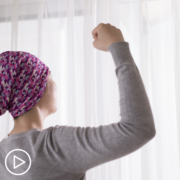
|
Katherine:
Well, once it’s time to treat, of course, then it’s time to think about treatment options. Let’s walk through the types of treatments that are used today to treat CLL.
Dr. Davids:
As I alluded to before, we historically have had chemotherapy-based approaches to treat CLL. And that was an effective way to temporarily put the disease into remission, but it had a lot of side effects and inevitably the CLL would come back. And the challenge particularly with chemotherapy-based approaches it that when the CLL does come back after chemotherapy, it tends to behave more aggressively and be harder to treat.
So, there have been quite a few studies over the last few years trying to figure out ways that we can avoid using chemotherapy as the first treatment, and this can involve treatments such as monoclonal antibodies. People may have heard of rituximab or a newer drug, obinutuzumab. There are the inhibitors of the B-cell receptor pathway, and this is for example ibrutinib (Imbruvica), which targets a protein called BTK, also a newer one called acalabrutinib (Calquence), which targets BTK. And then, I mentioned at the beginning these fixed-duration therapies that stop after a period of time. Many of those are based on a newer oral drug called venetoclax (Venclexta), which when we give it as a first therapy, we give in combination with that antibody obinutuzumab (Gazyva).
So, a bit of an alphabet soup. I know it gets confusing with all the different treatments, but the good news for CLL patients is, 1.) we have a lot of options, which is great, 2.) we don’t necessarily need to use chemotherapy anymore, and in fact I use it pretty rarely these days. One situation where I do still consider chemotherapy is for younger patients – which in the CLL world is sort of under age 60 or so – if they have very favorable biology to the disease, in particular this mutated IGHV.
That’s a scenario where the older chemotherapy regimen, FCR, can be very effective. It’s a six-month treatment, and we have patients with those molecular characteristics who are now 12, almost 15 years out from their initial six months, and they’re still in a complete remission. So, many of those patients have been functionally cured of their CLL from the six months of treatment. But again, there are some risks to that approach. We worry about other cancers that may be more likely after receiving FCR. We worry about infections, and particularly in the COVID situation, we worry about COVID infection in patients on chemotherapy.
So, it’s been pretty rare that I’ve been using that approach these days. I’ve been opting more for the novel agent-based approaches. So, often now the conversation as an initial therapy comes down to, “Do you prefer more of a continuous treatment strategy with a BTK inhibitor drug like ibrutinib or acalabrutinib, or do you like the idea of a time-limited therapy with one year of venetoclax in combination with obinutuzumab?” And I would say there’s pros and cons to both approaches, and we don’t know which one is the optimal one for CLL patients to start with, but probably I think most patients at some point in their lifetime are going to need one therapy or the other.
So, maybe in the end it doesn’t matter too much which one you start with if you’re going to get both eventually anyway. But we don’t know that yet.
How Does CLL Progress? Understanding the Stages of CLL from Patient Empowerment Network on Vimeo.
What are the specific stages of chronic lymphocytic leukemia (CLL), and how does CLL progress? Dr. Matthew Davids details the stages of CLL and indications for when it’s time to treat the condition.
Dr. Matthew Davids is Director of Clinical Research in the Division of Lymphoma at Dana-Farber Cancer Institute. Learn more about Dr. Davids here.

|
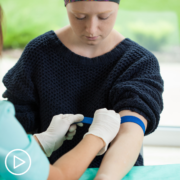
|
Katherine:
Okay. So, how does CLL progress? When do you know when it’s time to treat?
Dr. Davids:
The stages of CLL involve the progression of the disease. When we first meet patients, often they only have cells circulating in the blood, and that’s called stage 0 disease. It’s one of the few cancers where there’s actually a Stage 0 before even Stage I, and the reason for that is that many patients can go for years on Stage 0 disease. But as the burden of the CLL cells begin to accumulate in the body they can start to collect in their lymph nodes, and the lymph nodes can start to swell up whether it’s in the neck or the armpits or elsewhere. That’s stage I disease.
They can accumulate in the spleen, which is an organ in the abdomen. It’s kind of a big filter for your bloodstream, and as the filter traps more of these lymphocytes the spleen can slowly enlarge over time. That’s stage II disease.
And then finally, the CLL cells can get into the bone marrow, which is like the factory for making your blood cells. And if the factory floor gets all gummed up with CLL cells it can’t make the normal red cells, that’s called anemia. Or it can’t make the normal platelet cells, that’s called thrombocytopenia. And when we start to see those more advanced stages III and IV of CLL, that usually does require treatment. And what the treatment does is it clears out the factory floor and it allows for the normal machinery to make the normal blood cells again. So, that’s one of the more common reasons why treatment is needed is due to anemia and low platelets. Second reason can be if the lymph nodes or spleen get so bulky that they’re uncomfortable or threatening organs internally. We want to treat before that becomes a real threat.
And then, the third thing that usually happens as the disease progresses, patients can develop some symptoms, what we call constitutional symptoms. These can be things like unintentional weight loss, drenching night sweats that are happening on a consistent basis, and those sorts of things. So, if that’s happening at the same time as these other factors are progressing, those would be reasons to treat.
And notice that one thing I did not say is the white blood cell count itself.
That’s a common misconception. Some people think that as the white blood cell count goes higher – and people use all different thresholds, 100, 200 – that by crossing that threshold you need to start treatment. And in fact, that’s not the case. We have many patients whose white blood cell count can get very high but then it can kind of level off and plateau for a period of several years, and as long as they don’t meet those other treatment indications, they don’t need to be treated just based on the white count alone.
Should Patients “Watch and Wait” Before Starting CLL Treatment? from Patient Empowerment Network on Vimeo.
What do chronic lymphocytic leukemia (CLL) patients need to know about watch and wait? Dr. Matthew Davids shares the meaning of watch and wait, when it’s appropriate for CLL patients, and which factors are monitored to ensure the best care.
Dr. Matthew Davids is Director of Clinical Research in the Division of Lymphoma at Dana-Farber Cancer Institute. Learn more about Dr. Davids here.

|
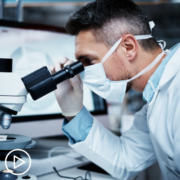
|
Katherine:
We have a question from the audience. Linda writes, “I’ve heard that CLL doesn’t need to be treated right away. Is that true?”
Dr. Davids:
That is true for the majority of CLL patients, and it’s actually a very counterintuitive thing. We’re conditioned that if you have cancer that it’s important to be proactive and get rid of it as quickly as possible, the sooner the better, and that is actually not the case in CLL. And we didn’t just take a guess that that’s the best approach. This is actually something that’s been studied in clinical trials. There were several clinical trials launched in the ‘70s and ‘80s looking at an early intervention strategy using a chemotherapy-based approach to see if treating at the time of diagnosis would be better than waiting until patients developed more significant symptoms.
And all of those studies did not show a benefit to early intervention.
Now, more recently those studies have been challenged as somewhat out of date, which is a fair criticism because they used an older chemotherapy drug. And so, there is a newer study now going on in Europe that is looking at early intervention with the drug ibrutinib, which is one of our novel agents for CLL, looking to see if early intervention with ibrutinib (Imbruvica), particularly for patients who have a higher risk form of CLL, may be beneficial.
But we have seen some data now already presented from this study that do not show any improvement in how long the patients live by treating with ibrutinib early, and we do see some of the typical side effects that we’re accustomed to seeing with ibrutinib. So, even with the newer data that we’re seeing, we still do not recommend early intervention for patients with CLL.
Katherine:
I’ve heard this term “watch and wait.” What does that mean?
Dr. Davids:
Yeah, it’s not the best term because it’s very passive. That refers to this observation strategy. I like to think of it more as “active surveillance.” It seems more proactive because you’re doing something about it.
You’re really checking the blood counts, you’re getting your physical exam, you’re checking in on symptoms, these sorts of things, and really keeping a close eye on the disease. And that’s the approach that we like to take
with our patients to really keep them engaged, making sure they’re staying up-to-date on their screenings for other cancers, making sure they’re getting vaccinations, these sorts of things are all the things we do with active surveillance.
Katherine:
How is someone monitored during this watch-and-wait period?
Dr. Davids:
It varies depending on individual patients. We’ve alluded to the fact that there’s different genetic subgroups of CLL already, so there are some patients that have higher-risk disease. The example of that usually is deletion 17p that people may have heard of on the FISH test. For those patients I usually am seeing them every three months or so, physical exam, checking on their history, checking their blood work. But there’s quite a few CLL patients who have lower-risk disease. If they have for example mutated IGHV, if they do not have the 17p for example, those patients may be able to be seen once every six months or so with a similar setup.
I don’t routinely get CAT scans on a regular basis for most patients. Most patients don’t need bone marrow biopsy tests unless they’re starting treatment. So, it’s mostly it’s exam, talking to patients, and checking the blood work.